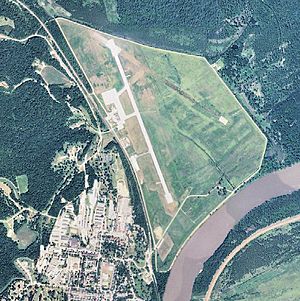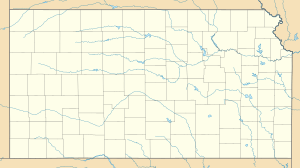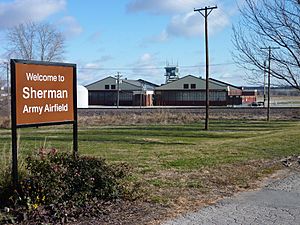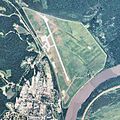Sherman Army Airfield facts for kids
Sherman Army Airfield (IATA: FLV, ICAO: KFLV) is an airport used by both civilians and the military. It is located at Fort Leavenworth, Kansas, in Leavenworth County, Kansas. Even though it's on a United States Army base, the city of Leavenworth, Kansas has an agreement that lets civilians use the airport at any time without needing special permission. Most of the flights from this airfield are civilian, with military use being much less frequent.
The airport gets its codes (FLV, KFLV) from Fort Leavenworth. It is named after Major William Carrington Sherman (1888–1927), an early pioneer in Army Aviation. He was an instructor at Fort Leavenworth and sadly passed away there in 1927. William Sherman wrote the Army's first manual on airplane tactics, called Air Tactics (1921), along with other important army airplane guides and histories.
Quick facts for kids Sherman Army AirfieldSherman Air Force Base |
|
|---|---|
| Located near Fort Leavenworth, Kansas | |

Sherman Army Airfield, 2006
|
|
| Coordinates | 39°22′04″N 094°55′04″W / 39.36778°N 94.91778°W |
| Type | Military/Civil Airfield |
| Site information | |
| Owner | United States Army |
| Site history | |
| Built | 1926 |
| In use | 1926–present |
|
Airfield information
|
|||||||||||
|---|---|---|---|---|---|---|---|---|---|---|---|
| Summary | |||||||||||
| Airport type | Military / public | ||||||||||
| Elevation AMSL | 772 ft / 235 m | ||||||||||
| Coordinates | 39°22′04″N 094°55′04″W / 39.36778°N 94.91778°W | ||||||||||
| Map | |||||||||||
| Runway | |||||||||||
|
|||||||||||
| Statistics (2018) | |||||||||||
|
|||||||||||
|
Source: Federal Aviation Administration
|
|||||||||||
Contents
Learning to Fly at Sherman Airfield
Leavenworth Aviation Services (LAC) is the main company that provides services at Sherman Army Airfield. It offers many things for pilots and planes. You can get your aircraft fixed or repaired here. They also have planes you can rent. If you want to learn how to fly, they offer flight lessons. You can also buy fuel for your plane or rent a hangar to store it.
Flight Training Programs
The flight school at Sherman Airfield helps students earn different pilot certificates. These include the Private Pilot Certificate, which lets you fly for fun. You can also get the Commercial Pilot Certificate, which allows you to fly for pay. Other advanced certificates like the Airline Transport Pilot Certificate and Flight Instructor Certificate are also available. The school has three types of aircraft for rent: a Piper PA-28 Cherokee, a Mooney M20, and a Piper PA-30 Twin Comanche.
Airfield Layout and Aircraft
Sherman Army Airfield covers an area of about 234 acres (95 ha). It is located at an elevation of 772 feet (235 meters) above sea level. This airfield does not have a control tower. It has one runway named 16/34. The runway surface is made of asphalt and concrete. It measures 5,318 feet long by 102 feet wide (1,772 x 30 meters).
In the year leading up to December 31, 2017, the airport had 20,400 aircraft operations. This means about 55 flights happened each day. Most of these flights, 94%, were general aviation (private or business flights). Only 6% were military flights. At that time, 31 aircraft were based at the airport. Most of these (97%) were single-engine planes, and 3% were multi-engine planes.
A Look Back at Sherman Airfield's History
From the very beginning, Sherman Army Airfield's main purpose was to provide flying facilities for the Command and General Staff School at Fort Leavenworth. Most of its use was for pilots assigned to the school. These pilots, whether students or instructors, used the field for practice flights to keep their skills sharp.
Early Days and Development
In the early 1920s, flying was done at an old polo ground a few miles from Sherman. But in 1926, an emergency landing strip that had been set up in 1923 was turned into a permanent airfield. An Army Air Corps group was stationed there to manage the field. The base was built on low ground near the Missouri River, close to Fort Leavenworth.
At first, the runways were just grass. But in 1930, three cinder runways were built. The longest of these was 4,000 feet. When the United States entered World War II, these runways were made even longer, reaching 6,000 feet. This length was enough for most types of aircraft used during the war. However, the ground could get very wet, especially when the river was high. So, in late 1944, concrete areas were added at the ends of the main runways. These runways crossed each other and were connected by a short strip, forming a shape like the letter "A." A large building called a hangar was built in 1932 to store planes. It was badly damaged by a fire in 1934, which also destroyed several planes. But it was repaired and used for the next 20 years. During World War II, several temporary buildings, including living quarters for soldiers, were added.
Sherman Airfield During World War II
During much of World War II, Sherman Airfield was directly managed by the Headquarters of the United States Army Air Forces. Later, in January 1944, it was assigned to the Third Air Force. The groups of people working at the airfield changed over time. For example, the 355th Air Base Unit took over from the Third Staff Squadron in April 1944.
Early in the war, when there weren't many airfields available, Sherman Army Airfield was used for training. In 1941, two National Guard units, the 124th and 127th Observation Squadrons, trained there. They left in April 1942. In 1942, cadets from the Royal Netherlands Air Force also received their first flight lessons at Sherman. Other than these training periods, the base mainly helped pilots from the Command and General Staff School practice their flying skills. It also handled flights for official business and planes just passing through.
By May 1944, Sherman had only 25 planes, mostly trainers. But as more pilots with combat experience came to study at Fort Leavenworth, better planes were needed. In June 1944, 15 new planes arrived, including some P-40 Warhawks. By the end of the war, over 60 aircraft were based at Sherman, with at least ten of them being P-51 Mustangs. Air traffic increased a lot. In July 1945, there were 868 local flights and 357 longer flights from the base.
Many important visitors came to Sherman over the years, usually for meetings or ceremonies at Fort Leavenworth. These included famous generals like Gen. Henry H. Arnold in 1944, who was the Commanding General of the Army Air Forces. In 1946, General of the Army Dwight D. Eisenhower, who later became president, also visited. Other notable visitors included British general Marshal Sir Bernard Montgomery in 1953.
After the War
After World War II, Sherman Airfield's management changed. In 1946, it became part of the newly formed Tactical Air Command. Then, in 1948, it was given to the Tenth Air Force. When the United States Air Force was created in September 1947, Sherman's name was changed to Sherman Air Force Base in January 1948. The units stationed there also changed names.
After the war, operations at Sherman became much smaller. By mid-1947, there were only 13 aircraft at the field, and sometimes even fewer. In July 1950, only a small number of officers and airmen were assigned to the base. This was possible because Fort Leavenworth continued to provide most of the necessary support services for Sherman. In 1951, the base took on a new task: providing basic flight training for officers at 11 locations, mostly ROTC (Reserve Officers' Training Corps) groups, in Kansas and nearby states.
Returning to Army Control
In the summer of 1953, the Tenth Air Force decided that Sherman Air Force Base should be closed to save money. They planned to move its training activities elsewhere. The Air Force headquarters approved this plan. On October 25, the unit managing the base was officially closed. On January 1, 1953, the control of the airfield was formally given back to the United States Army.
Sherman Airfield Today
The airport is located at the bottom of the Missouri River bluffs near the fort. Because of its location, it has often been affected by floods. The protective wall (levee) around it broke during the Great Flood of 1951, the Great Flood of 1993, the 2011 Missouri River flood, and the 2019 Midwestern U.S. floods. Each time, Sherman Airfield was covered in water.
Sherman Airfield is also home to one of the last Army flying clubs in the United States. The Fort Leavenworth Army Flying Club and the Red Stone Arsenal Flying Club are the only two active Army clubs today. The Fort Leavenworth Army Flying Club started in 1958. For many years, it was located on the north side of the airfield. Later, the club moved inside the large hangar at the airfield. This club gives active duty and retired soldiers the chance to earn their pilot's certificate. However, after the 2019 floods, the club's activities almost stopped completely.
Images for kids









